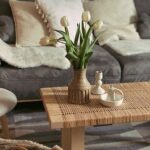Incorporating plants into your interior design can transform your space, creating a welcoming and breathable environment. Indoor plants not only add aesthetic appeal, but also offer numerous health benefits, such as improving air quality and reducing stress. Whether it’s for your living room, office, or bedroom, adding plants to your interior design can significantly enhance the look and feel of your space. In this article, we will discuss the various benefits of incorporating plants into your interior design, and provide tips on how to choose the right plants for your space.
Enhancing your interior aesthetics with plants
The addition of plants to any room can instantly elevate its visual appeal. Houseplants come in various shapes, colors, and sizes, allowing you to create an interior design that suits your personal style and preferences. By carefully selecting and arranging your indoor plants, you can transform an ordinary room into an inviting, vibrant living space.
Improved visual appeal
The natural beauty of plants can add a touch of elegance and sophistication to any room. With their myriad shapes, textures, and colors, they serve as stunning decorative elements, making your space feel alive and inviting. Whether you opt for a lush, tropical look or prefer a minimalist, Scandinavian design, incorporating houseplants can enhance the overall aesthetic of your interior.
Creating focal points and spatial awareness
Strategically placing plants within your room can create focal points, drawing the eye to certain areas while making the space feel larger. For instance, a large potted plant can create an eye-catching centerpiece in a living room or break up an empty wall. Similarly, placing plants at different heights or clustering a few smaller plants together can add depth, dimension, and visual interest to your space.
Health benefits of indoor plants
Beyond their aesthetic appeal, indoor plants offer numerous health benefits. From improving air quality to reducing stress levels, incorporating plants into your interior design can help create a healthier and more comfortable living environment.
Improved air quality
Indoor plants are natural air purifiers, absorbing harmful pollutants and releasing fresh, clean oxygen. Through the process of photosynthesis, plants remove toxic substances such as benzene, formaldehyde, and trichloroethylene from the air, improving overall air quality. This, in turn, promotes better respiratory health and reduces the risk of allergies, asthma, and other respiratory ailments.
Stress reduction and mental wellbeing
Having plants in your living or work environment has been shown to reduce stress, boost mood, and enhance cognitive function. The presence of plants can create a sense of calm and well-being, lowering anxiety levels and promoting relaxation. Additionally, caring for plants can serve as a therapeutic activity, helping to relieve stress while nurturing a sense of accomplishment.
Choosing the right plants for your space
To maximize the benefits of incorporating plants into your interior design, it’s important to select the appropriate plants for your space. Factors such as light, temperature, and humidity should be taken into account, as well as your ability to care for the plants.
Assessing light and temperature requirements
Different plants have varying light and temperature requirements, so it’s essential to choose plants that will thrive in your space. Determine the amount of light your room receives and choose plants accordingly. For instance, low-light areas can accommodate plants like snake plants, pothos, and ZZ plants, while brighter spots can benefit from plants like fiddle leaf figs, monstera, and spider plants.
Considering plant maintenance and care
When selecting indoor plants, it’s important to consider how much time and effort you’re willing to dedicate to their care. Some plants require more maintenance than others, so choose plants that align with your lifestyle and schedule. Low-maintenance plants like succulents, air plants, and philodendrons are ideal for those with limited time or experience.
Incorporating plants into various interior design styles
Plants can be seamlessly integrated into a wide range of interior design styles, adding a unique and personalized touch to your space.
Modern and minimalist designs
For a modern or minimalist interior design, opt for plants with clean lines and sculptural appeal. Snake plants, rubber plants, and palms can add a striking visual element while maintaining a sleek and clutter-free aesthetic.
Bohemian and eclectic designs
If your interior design leans toward bohemian or eclectic, incorporate a variety of houseplants with different textures, colors, and sizes. Mixing and matching plants like pothos, ferns, and spider plants can create a lush, vibrant atmosphere that complements your unique style.
In conclusion, incorporating plants into your interior design offers numerous benefits, from enhancing visual appeal to promoting health and wellbeing. By carefully selecting and integrating plants into your space, you can create an inviting, breathable, and visually stunning environment that reflects your personal style. Whether it’s your home or office, indoor plants can transform your space into a vibrant and nurturing haven.



